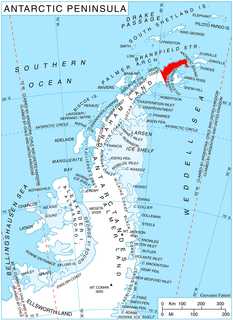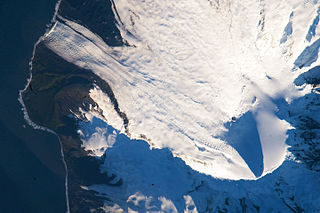
The Prince Charles Mountains are a major group of mountains in Mac. Robertson Land in Antarctica, including the Athos Range, the Porthos Range, and the Aramis Range. The highest peak is Mount Menzies. Other prominent peaks are Mount Izabelle and Mount Stinear. These mountains together with other scattered peaks form an arc about 260 miles long, extending from the vicinity of Mount Starlight in the north to Goodspeed Nunataks in the south.

Cape Flying Fish is an ice-covered cape which forms the western extremity of Thurston Island. It was discovered by Rear Admiral Richard E. Byrd and members of the US Antarctic Service in a flight from the Bear in February 1940. It was named by the Advisory Committee on Antarctic Names for the United States Exploring Expedition ship Flying Fish, commanded by Lieutenant William M. Walker, U.S. Navy, which reached a point within 125 miles of this cape; the ship's position on the morning of March 23, 1839 was 70°0′S 100°16′W.

Schmidt Glacier is a glacier, 0.7 nautical miles (1.3 km) long, flowing west from Baudissin Glacier between Mount Drygalski and North West Cornice, on the west side of Heard Island in the southern Indian Ocean. To the north of Schmidt Glacier is Baudissin Glacier, whose terminus is located at the western side of Corinthian Bay, near Sealers Cove. Kildalkey Head is west of Schmidt Glacier. To the south of Schmidt Glacier is Vahsel Glacier, whose terminus is at South West Bay, between Erratic Point and Cape Gazert. Immediately south of Vahsel Glacier is Allison Glacier. Click here to see a map of Schmidt Glacier and the northwestern coast of Heard Island.
South West Bay is an open bay indenting the west side of Heard Island immediately north of Cape Gazert in the southern Indian Ocean. The bay was roughly charted on an 1860 sketch map compiled by Captain H.C. Chester, an American sealer. The name "S.W. Bay" appears on an 1882 chart compiled by Ens. Washington Irving Chambers aboard the USS Marion at Heard Island in January 1882. The bay name appears to have developed from an American sealer name, "Southwest Beach," in use about 1860 for the pebble beach at the north end of this bay.
Erratic Point is a small, moss-covered point at the head of South West Bay, 1.3 nautical miles (2.4 km) northeast of Cape Gazert, on the west side of Heard Island in the southern Indian Ocean. The First German Antarctica Expedition in 1902 charted a cape in this vicinity, from the summit of Mount Drygalski, and applied the name "Kap Lerche." In November 1929 the British Australian and New Zealand Antarctic Research Expedition under Douglas Mawson charted a small point in this position and applied the name "Erratic Point" because of the large number of massive erratic boulders encountered there. The Australian National Antarctic Research Expedition was unable to find any significant feature in this immediate area during their 1948 survey of the island, hence the name Erratic Point was retained by them for this small point.
McDonald Bay is an open bay in the Davis Sea, 10 nautical miles (19 km) wide at its entrance between Adams Island and the Haswell Islands, lying immediately west of Mabus Point on the coast of Antarctica. It was charted by the Australasian Antarctic Expedition under Douglas Mawson, 1911–14, and was named by the Advisory Committee on Antarctic Names after Commander Edwin A. McDonald, U.S. Navy, Commander of the USS Burton Island, flagship of the two icebreakers which supported the U.S. Navy Operation Windmill parties which established astronomical stations along Wilhelm II, Queen Mary, Knox and Budd Coasts during the 1947–48 summer season.

Bellisime Glacier is a glacier about 4 nautical miles (7 km) long flowing south from Thurston Island east of Myers Glacier. It was named by the Advisory Committee on Antarctic Names after Lynda B. Bellisime of the United States Geological Survey (USGS), Flagstaff, Arizona, part of the USGS team that compiled the 1:5,000,000-scale Advanced Very High Resolution Radiometer maps of Antarctica and the 1:250,000-scale Landsat TM image maps of the Siple Coast area in the 1990s.
Mount Brazil is a mountain, 2,090 metres (6,860 ft) high, at the south end of the McGregor Range in the Admiralty Mountains. It was mapped by the United States Geological Survey (USGS) from surveys and from U.S. Navy air photos, 1960–62, and named by the Advisory Committee on Antarctic Names for Chief Warrant Officer John D. Brazil, USA, helicopter pilot supporting the USGS Topo North–South party that surveyed the area, 1961–62.
Chocolate Nunatak is an isolated nunatak of reddish-brown color at the east side of the head of Mariner Glacier, 3 nautical miles (6 km) west-southwest of Mount McCarthy, Barker Range, in Victoria Land, Antarctica. A descriptive name apparently applied by B.W. Riddolls and G.T. Hancox, geologists with the New Zealand Antarctic Research Program Northern Party to the upper Mariner Glacier in 1966–67. The geographical feature lies on the Pennell Coast, a portion of Antarctica lying between Cape Williams and Cape Adare.
Needle Island is a pinnacle rock lying 0.2 nautical miles (0.4 km) west of the north end of McDonald Island in the McDonald Islands. Surveyed and given this descriptive name by ANARE in 1948.

Diplock Glacier is a narrow straight glacier, 10 miles (16 km) long, flowing eastward from Detroit Plateau, on Trinity Peninsula in Graham Land, into Prince Gustav Channel 5 miles (8 km) south of Alectoria Island. It is situated south of Marla Glacier and north of Zavera Snowfield. The feature was mapped from surveys by the Falkland Islands Dependencies Survey (1960–61), and was named by the UK Antarctic Place-Names Committee for Bramah Joseph Diplock, a British engineer who made considerable advances in the design of chain-track tractors (1885–1913).

Mount Dowling is a small mountain overlooking the south coast of Thurston Island, about 13 nautical miles (24 km) east of Von der Wall Point. It was mapped by the United States Geological Survey from surveys and U.S. Navy air photos, 1960–66, and was named by the Advisory Committee on Antarctic Names for Forrest L. Dowling, a geophysicist at Byrd Station, 1960–61.

Linsley Peninsula is a broad, roughly rectangular ice-covered peninsula which protrudes into the south part of Murphy Inlet, northern Thurston Island, Antarctica, dividing the inlet into two arms at the head. The peninsula was first plotted from air photos taken by U.S. Navy Operation Highjump, 1946–47, and was named by the Advisory Committee on Antarctic Names for Lieutenant Commander Richard G. Linsley, U.S. Navy, a pilot of LC-130 Hercules aircraft who made flights in support of the United States Antarctic Research Program geological party working at Thurston Island in the 1968–69 season.
Mount McDonald is a peak rising to 2,470 metres (8,100 ft) on the north side of Trafalgar Glacier, 4 nautical miles (7 km) northwest of Mount Burton, in the Victory Mountains of Victoria Land, Antarctica. It was named by the New Zealand Federated Mountain Clubs Antarctic Expedition (NZFMCAE), 1962–63, for William McDonald, a crew member on the Terra Nova during the British Antarctic Expedition, 1910–13. McDonald, who lived in New Zealand, was a guest of the U.S. Navy during the 1962–63 Antarctic season when he visited the continent again with two others of Robert Falcon Scott's veterans.
McElroy Ridge is a mountainous ridge, 16 nautical miles (30 km) long, in the Victory Mountains of Victoria Land, Antarctica. The ridge is bounded by the Gruendler, Trainer, Trafalgar and Rudolph Glaciers. It was mapped in part by the New Zealand Geological Survey Antarctic Expedition, 1957–58, and mapped in detail by the United States Geological Survey from surveys and U.S. Navy air photos, 1960–62. The ridge was named by the Advisory Committee on Antarctic Names for William D. McElroy, Director of the National Science Foundation, 1969–72.

Highton Glacier is a glacier on the east coast of Clarence Island in the South Shetland Islands, south of Sugarloaf Island, flowing northeast to the sea. Called "Stamina Glacier" from the stamina needed to cross it by the Joint Services Expedition to the Elephant Island Group, 1976–77, it was named by the UK Antarctic Place-Names Committee in 1980 after Commander John E. Highton, Royal Navy, Deputy Leader of the expedition and in charge of the group on Clarence Island.
Man-o-War Glacier is a tributary glacier in the Admiralty Mountains of Antarctica. It drains the vicinity south of Mount Black Prince and Mount Royalist and flows southward to enter Tucker Glacier between the McGregor Range and Novasio Ridge. The glacier was named for a "man-o-war" in association with the Admiralty Mountains by the New Zealand Geological Survey Antarctic Expedition of 1957–58.








